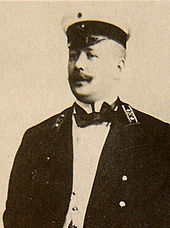Mikhail Ossipowitsch Eisenstein

Mikhail Ossipowitsch Eisenstein ( Russian Михаил Осипович Эйзенштейн , Latvian Mihails Eizenšteins ; born September 5, 1867 in Bila Zerkwa , † July 1, 1920 in Berlin ) was a Russian civil engineer and architect of Art Nouveau .
life and work
Eisenstein was in Bila Tserkva in what was then the Russian Empire belonging Kiev Governorate in a family German- Jewish origin paternal and maternal born Swedish. The family professed the Russian Orthodox faith . Eisenstein studied at the Institute for Civil Engineering (Институт гражданских инженеров) in Saint Petersburg, whose diploma he obtained in 1893. In the same year he started working in Riga . He became head of the Riga building administration; later he headed the Baltic state Office buildings and roads of the province Livonia . In 1915 he was appointed to the Council of State, which means that according to the ranking table of Russian career titles, he was entitled "Your High Born ".
With his Art Nouveau architecture, Eisenstein opposed the neoclassical architecture based on the Saint Petersburg model that prevailed in Riga at the time . At the beginning of his architectural career, Eisenstein was ridiculed as a “crazy confectioner ”; as an “Art Nouveau architect”, however, he later received many honors and awards. Eisenstein designed his houses starting with the richly decorated facade, the details of which he drew meticulously. Only then did he plan the rest “behind the facade”. With more than fifty houses designed by him, he decisively shaped the cityscape of the New Town of Riga . Today the new town is under the protection of the UNESCO World Heritage .
Eisenstein separated from his Russian wife Julia Konezkaja, the daughter of a merchant from the "First Guild", in 1909, whereby he was granted custody of their son Sergei Mikhailovich Eisenstein, who was born in 1898 . Sergei lived with his father until he finished high school, after which he went to study in Petrograd .
Michail Eisenstein - in contrast to his son - could not identify with the ideas of the October Revolution and emigrated to Berlin , where he died in 1920. He was buried in the cemetery of the Russian Orthodox community in Berlin-Tegel . His son became a well-known director in the Soviet Union.
literature
- Mārtiņš Sīlis: Michail Eisenstein. A master of Art Nouveau in Riga . Madris, Riga 2012, ISBN 9984-316-98-X .
Footnotes
- ^ Ronald Bergan: Sergei Eisenstein. A life in conflict . Warner, London 1999, ISBN 0-7515-2643-6 , p. 125.
- ↑ Зашифрованное зодчество Риги . In: АЛЕФ . ( alefmagazine.com [accessed November 7, 2018]).
- ↑ Биография Михаил Эйзенштейн. Retrieved November 7, 2018 .
- ↑ a b Art. Mikhail Eisenstein . In: Grigorijs Smirins: Outstanding Jewish personalities in Latvia . Nacionālais Apgāds, Riga 2003, ISBN 9984-26-114-X , p. 17.
Web links
- Michail Eisenstein in the Latvian culture portal
- Latvian dates and events ( Russian )
- Biography of Michail Eisenstein ( Russian )
| personal data | |
|---|---|
| SURNAME | Eisenstein, Michail Ossipowitsch |
| ALTERNATIVE NAMES | Эйзенштейн, Михаил Осипович (Russian); Eizensteins, Mihails (Latvian) |
| BRIEF DESCRIPTION | German-Baltic architect of Art Nouveau |
| DATE OF BIRTH | September 5, 1867 |
| PLACE OF BIRTH | St. Petersburg |
| DATE OF DEATH | July 1, 1920 |
| Place of death | Berlin |

